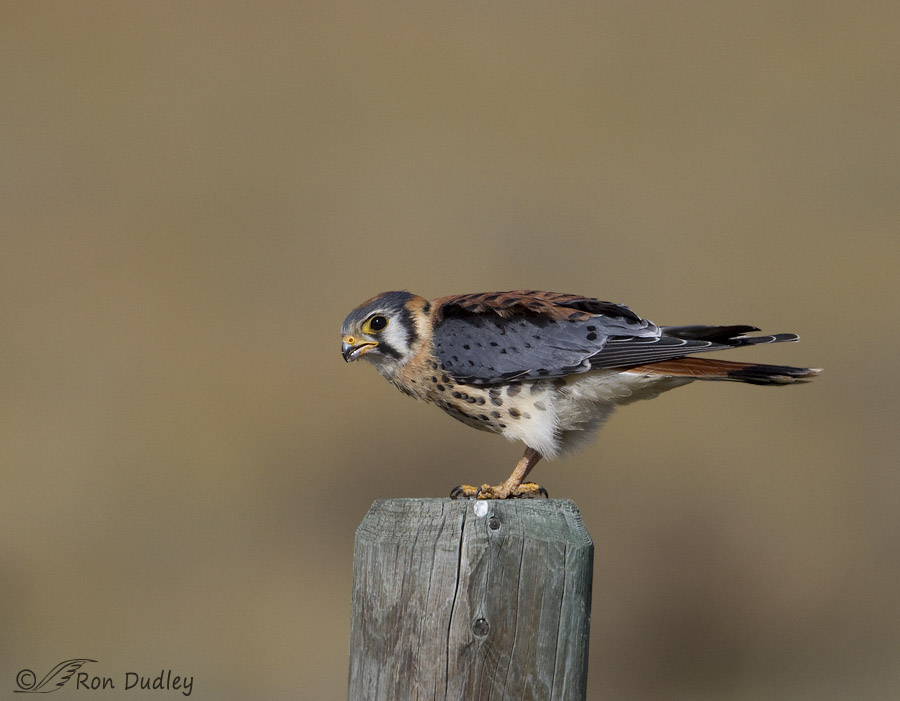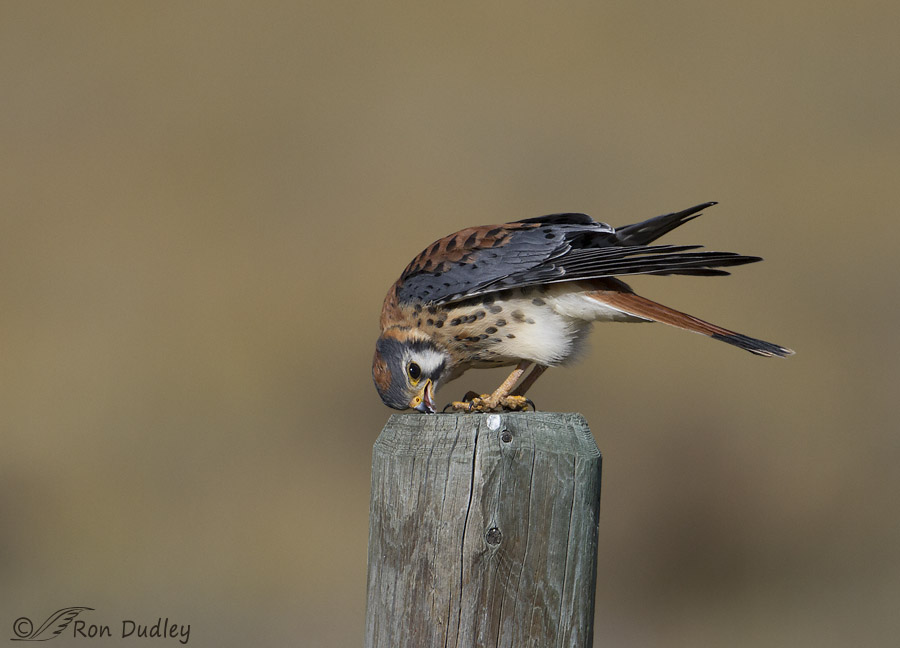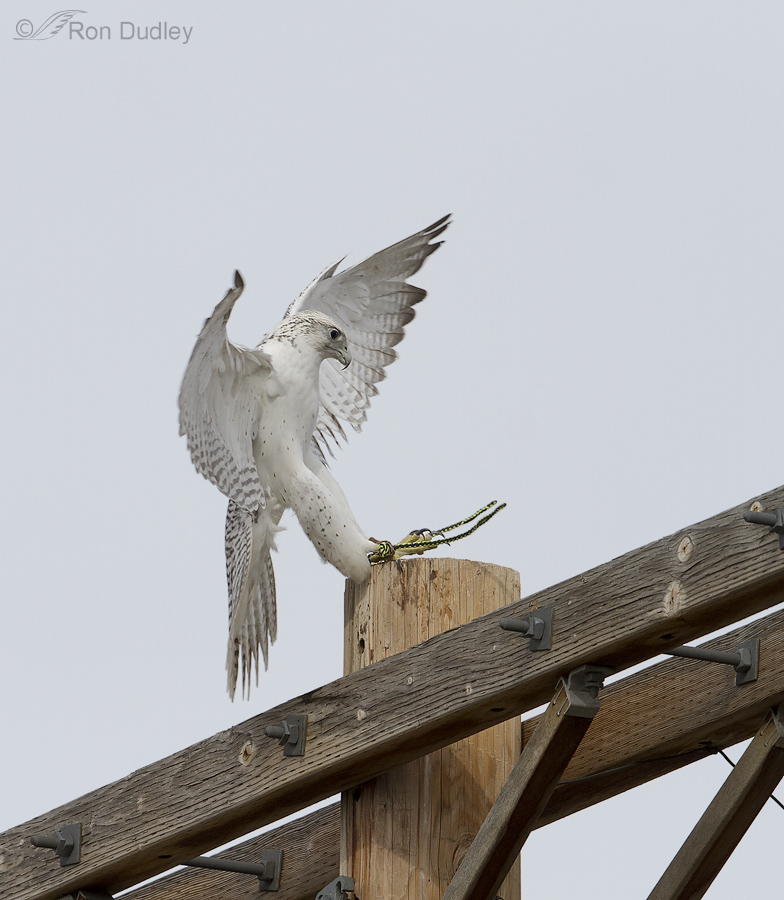Both wild raptors and those who care for captive birds must pay particular attention to beak health. In the wild the act of dissecting prey and tearing meat off of bones helps to maintain proper beak shape and proportions through the processes of wear and physical stress. In addition, raptors instinctively strop and hone their beaks as they clean them on their perch after a meal.

1/4000, f/6.3, ISO 500, Canon 7D, Canon EF500mm f/4L IS II USM +1.4tc, not baited, set up or called in
This male American Kestrel had just finished a meal. He has some food bits and blood on his beak and his posture suggested to me what he was about to do.

1/4000, f/6.3, ISO 500, Canon 7D, Canon EF500mm f/4L IS II USM +1.4tc, not baited, set up or called in
He reached down and cleaned his beak on the top of the post. But it was more than just cleaning – he stropped both sides of his beak many times on the hard end grain of the post, similar to what I do when I’m honing my kitchen knives.
Those who keep captive raptors (falconers, rehabbers, zoos etc) must pay close attention to the health and shape of the beaks of the birds they care for, partly because when fed boneless/soft food beaks tend to become overgrown and misshapen which can cause the upper mandible to crack. In addition, captive birds often do not have access to proper perches to hone their beaks on. When this happens to the beak of a captive raptor it must be “coped” (shaping a bird’s beak back to its ideal shape) and that can be a traumatic experience for both patient and handler.
More here on the process of and need for coping if you have the interest.
 1/1600, f/7.1, ISO 500, Canon 7D, Canon EF500mm f/4L IS II USM
1/1600, f/7.1, ISO 500, Canon 7D, Canon EF500mm f/4L IS II USM
This drop-dead gorgeous white Gyrfalcon is a falconry bird that escaped last winter. I photographed it locally just before it was recaptured and eventually returned to its owner. Before it was returned its health was evaluated and though its beak had not been neglected it was ready for coping – the tip of the upper mandible had grown past a right angle and is about to curl around under the lower mandible. A natural diet and perches in the wild would likely have prevented the overgrowth.
This bird escaped a second time last month and had to be recaptured and once again returned to its owner.
Ron


Sensational shots Ron!
Charlotte
It’s good that there are no evident signs of abuse, such as those seen so often on “pet” tigers and lions.
AMEN! Dick Harlow!!!
Sigh on the Gryfalcon front. An owner who doesn’t take his/her responsibilities and obligations anywhere near seriously enough. It is a glorious bird, and I am so sorry that, judging by your comments, its yearning for freedom is likely to end badly.
Thank you for the comments everyone.
A little background on this particular Gyrfalcon – if I remember correctly (and I believe I do) the bird was captive bred and purchased from a breeder. It’s open market monetary value is somewhere in the range of $5000+ and it’s my understanding that the bird is not hunted but rather kept as what I would call a glorified pet. It very likely would not survive in the wild.
OK, then all I can hope for is that it gives its master fits by escaping and being re-caught as much as possible!
Sorry, I guess I feel for this majestic falcon and the situation it is in. Its predicament is not of its making. Its only desire is what its DNA is telling it to do. I can’t get the beauty of this falcon out of my mind! Such a majestic beauty!
“Its predicament is not of its making. Its only desire is what its DNA is telling it to do.”
Well said, Dick.
Gorgeous photos of the Kestrel. I feel badly for the white Gyrfalcon – I agree with Patty and Dick that the bird wants to be free. And deserves it.
I’m with you, Dick…I think that incrediibly magnifient bird wants its freedom…don’t we all??? The first things I noticed were the jesses….How I hate to see them! I always worry about the potential for the bird escaping, getting snagged, suffering and eventually starving. I’m never happy to see signs of “management by man” with any critter meant to be free (yes, I know the rationale, but still don’t like it). My falconer friend uses telemetry to track his birds, but the threat is still there.
Oh what a beautiful falcon, saw my life dark phase in 2000 and it is ingrained in my brain, so much so it is on my number plate like someone else I know!! VBG
I’m probably a minority, but feel this bird wants its freedom. Just hope if the three strikes and your out saying comes true, it will mean she/he will get its freedom, but unfortunately I doubt it.
Great shots and good lesson, thanks.
Sounds like the bird or the owner needs to revisit basic training. I love watching falcons and have dreamed of being in that hobby some day. But I begin to think I wouldn’t enjoy it. They need to be flying free.
“Sounds like the bird or the owner needs to revisit basic training.”
Most likely the latter, Arwen.